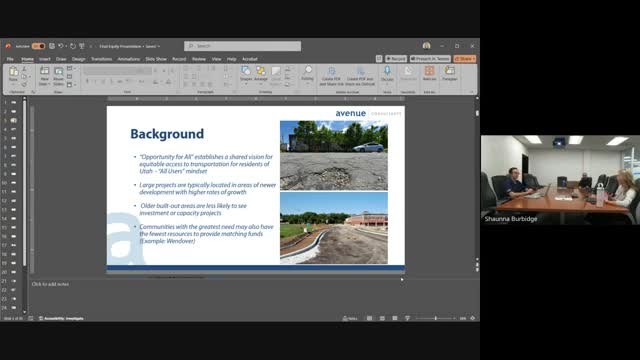Communities struggle for funding amid infrastructure disparities
October 13, 2024 | Utah Department of Transportation, Utah Government Divisions, Utah Legislative Branch, Utah
This article was created by AI summarizing key points discussed. AI makes mistakes, so for full details and context, please refer to the video of the full meeting. Please report any errors so we can fix them. Report an error »

In a recent government meeting, officials discussed the disparity in infrastructure investment between newer and older communities, highlighting a trend where large projects are predominantly concentrated in areas experiencing growth. These newer developments often receive significant funding for capacity improvement projects, such as adding lanes, repaving roads, and enhancing pedestrian amenities like bike lanes and sidewalks.
Conversely, older neighborhoods, particularly those established before the 1950s, are frequently overlooked for such investments. These areas tend to have stable populations and do not exhibit the same urgent need for capacity enhancements, resulting in a lack of funding for essential infrastructure improvements. This trend raises concerns about equity, as many of these older communities also struggle with limited financial resources to match grant funding for projects.
An illustrative example shared during the meeting was the experience of Wendover, where a Safe Routes to School sidewalk project took seven years for the city to secure the necessary matching funds. This situation underscores the challenges faced by smaller towns that often lack the budgetary flexibility to contribute to grant programs, which typically require local funding to access state or federal resources.
Officials emphasized the importance of focusing on equity in infrastructure planning, particularly in areas identified by the Wasatch Front Regional Council (WFRC) as having high needs based on demographic and household characteristics. The discussion highlighted the necessity of evaluating and addressing the infrastructure deficits in these equity focus areas to ensure that all communities receive the support they require for safe and accessible transportation options.
Conversely, older neighborhoods, particularly those established before the 1950s, are frequently overlooked for such investments. These areas tend to have stable populations and do not exhibit the same urgent need for capacity enhancements, resulting in a lack of funding for essential infrastructure improvements. This trend raises concerns about equity, as many of these older communities also struggle with limited financial resources to match grant funding for projects.
An illustrative example shared during the meeting was the experience of Wendover, where a Safe Routes to School sidewalk project took seven years for the city to secure the necessary matching funds. This situation underscores the challenges faced by smaller towns that often lack the budgetary flexibility to contribute to grant programs, which typically require local funding to access state or federal resources.
Officials emphasized the importance of focusing on equity in infrastructure planning, particularly in areas identified by the Wasatch Front Regional Council (WFRC) as having high needs based on demographic and household characteristics. The discussion highlighted the necessity of evaluating and addressing the infrastructure deficits in these equity focus areas to ensure that all communities receive the support they require for safe and accessible transportation options.
View full meeting
This article is based on a recent meeting—watch the full video and explore the complete transcript for deeper insights into the discussion.
View full meeting

